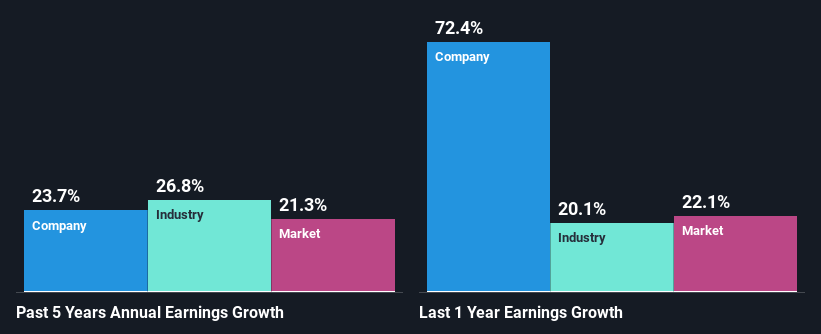- India
- /
- Specialty Stores
- /
- NSEI:TBZ
Is Tribhovandas Bhimji Zaveri Limited's (NSE:TBZ) Recent Stock Performance Influenced By Its Fundamentals In Any Way?
Tribhovandas Bhimji Zaveri's (NSE:TBZ) stock is up by a considerable 11% over the past week. As most would know, fundamentals are what usually guide market price movements over the long-term, so we decided to look at the company's key financial indicators today to determine if they have any role to play in the recent price movement. In this article, we decided to focus on Tribhovandas Bhimji Zaveri's ROE.
ROE or return on equity is a useful tool to assess how effectively a company can generate returns on the investment it received from its shareholders. Simply put, it is used to assess the profitability of a company in relation to its equity capital.
Check out our latest analysis for Tribhovandas Bhimji Zaveri
How Do You Calculate Return On Equity?
Return on equity can be calculated by using the formula:
Return on Equity = Net Profit (from continuing operations) ÷ Shareholders' Equity
So, based on the above formula, the ROE for Tribhovandas Bhimji Zaveri is:
9.3% = ₹527m ÷ ₹5.7b (Based on the trailing twelve months to September 2023).
The 'return' refers to a company's earnings over the last year. One way to conceptualize this is that for each ₹1 of shareholders' capital it has, the company made ₹0.09 in profit.
What Is The Relationship Between ROE And Earnings Growth?
We have already established that ROE serves as an efficient profit-generating gauge for a company's future earnings. We now need to evaluate how much profit the company reinvests or "retains" for future growth which then gives us an idea about the growth potential of the company. Assuming all else is equal, companies that have both a higher return on equity and higher profit retention are usually the ones that have a higher growth rate when compared to companies that don't have the same features.
Tribhovandas Bhimji Zaveri's Earnings Growth And 9.3% ROE
On the face of it, Tribhovandas Bhimji Zaveri's ROE is not much to talk about. Next, when compared to the average industry ROE of 14%, the company's ROE leaves us feeling even less enthusiastic. Despite this, surprisingly, Tribhovandas Bhimji Zaveri saw an exceptional 24% net income growth over the past five years. We reckon that there could be other factors at play here. For instance, the company has a low payout ratio or is being managed efficiently.
We then performed a comparison between Tribhovandas Bhimji Zaveri's net income growth with the industry, which revealed that the company's growth is similar to the average industry growth of 27% in the same 5-year period.

The basis for attaching value to a company is, to a great extent, tied to its earnings growth. The investor should try to establish if the expected growth or decline in earnings, whichever the case may be, is priced in. This then helps them determine if the stock is placed for a bright or bleak future. One good indicator of expected earnings growth is the P/E ratio which determines the price the market is willing to pay for a stock based on its earnings prospects. So, you may want to check if Tribhovandas Bhimji Zaveri is trading on a high P/E or a low P/E, relative to its industry.
Is Tribhovandas Bhimji Zaveri Using Its Retained Earnings Effectively?
Tribhovandas Bhimji Zaveri's three-year median payout ratio is a pretty moderate 29%, meaning the company retains 71% of its income. So it seems that Tribhovandas Bhimji Zaveri is reinvesting efficiently in a way that it sees impressive growth in its earnings (discussed above) and pays a dividend that's well covered.
Besides, Tribhovandas Bhimji Zaveri has been paying dividends for at least ten years or more. This shows that the company is committed to sharing profits with its shareholders.
Summary
On the whole, we do feel that Tribhovandas Bhimji Zaveri has some positive attributes. Even in spite of the low rate of return, the company has posted impressive earnings growth as a result of reinvesting heavily into its business. While we won't completely dismiss the company, what we would do, is try to ascertain how risky the business is to make a more informed decision around the company. Our risks dashboard would have the 3 risks we have identified for Tribhovandas Bhimji Zaveri.
Valuation is complex, but we're here to simplify it.
Discover if Tribhovandas Bhimji Zaveri might be undervalued or overvalued with our detailed analysis, featuring fair value estimates, potential risks, dividends, insider trades, and its financial condition.
Access Free AnalysisHave feedback on this article? Concerned about the content? Get in touch with us directly. Alternatively, email editorial-team (at) simplywallst.com.
This article by Simply Wall St is general in nature. We provide commentary based on historical data and analyst forecasts only using an unbiased methodology and our articles are not intended to be financial advice. It does not constitute a recommendation to buy or sell any stock, and does not take account of your objectives, or your financial situation. We aim to bring you long-term focused analysis driven by fundamental data. Note that our analysis may not factor in the latest price-sensitive company announcements or qualitative material. Simply Wall St has no position in any stocks mentioned.
About NSEI:TBZ
Tribhovandas Bhimji Zaveri
Designs, manufactures, retails, and sells jewelry primarily in India.
Proven track record with mediocre balance sheet.
Similar Companies
Market Insights
Community Narratives



